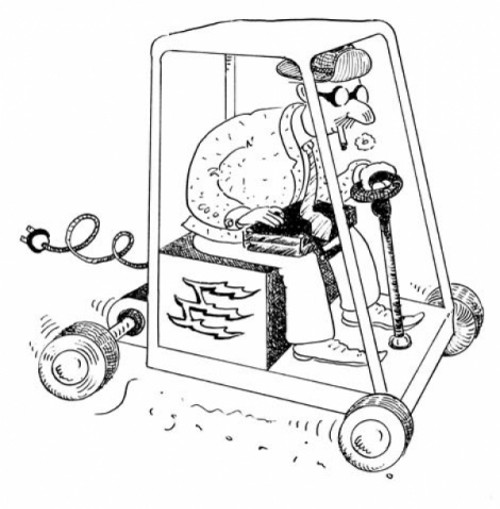Not following you, Dano. You’re saying we should encourage transit use even if it wastes energy because transit is inherently cool? This is a questionable policymaking aim. However, confusing claims on this subject are widespread. Consider the following:
• “Current publictransportation usage reduces U.S. gasoline consumption by 1.4 billion gallons each year. … Total national fuel savings from public transportation would double, to 2.8 billion gallons per year or more, if improved coordination between landuse plans and public transportation could replace even more car travel. —“Public Transportation and Petroleum Savings in the U.S.,” report prepared for the American Public Transportation Association, 2007
• “Even if we could get more people to ride transit, transit uses as much energy, and emits nearly as much greenhouse gases, as cars; and the trends suggest that cars will be more environmentally friendly than any transit system in the country by 2025.” —Randal O’Toole, senior fellow, Cato Institute
Appears we’ve got a diversity of opinion. Time for the Straight Dope to step in.
Let’s compare the average energy efficiency of different methods of transportation, expressed in British thermal units (BTUs) per passenger mile. These numbers were compiled or computed from government sources by my assistant Una, a professional engineer:
• Motorcycle—2,200 with single rider.
• Heavy rail (includes subway and commuter rail but excludes light rail/streetcar)— 2,600; New York City
• MTA rail—2,000.Commercial aircraft—3,100.
• Bus—4,300.
• Auto—5,500 with single occupant, 3,500 with average passenger load.
A few observations:
1. Setting aside the atypical case of New York City MTA rail, motorcycles are tops, energy efficiency-wise. However, I’m not seeing them as a practical commuting option for the average cube-farm denizen.
2. Trains are efficient, but not that efficient. If you’ve ever been packed into a subway car at rush hour, you might think it’d beat auto efficiency by 10 to one. Uh-uh— rail travel is a modest 30 percent more efficient than autos, on average. New York City MTA rail is close to three times as efficient as a car driven solo, but again, that’s the extreme case. Chicago CTA rail, admittedly an outlier on the other end, consumes 4,200 BTUs per passenger mile, making it less efficient than the average car.
3. Buses are more efficient than a passengerless car, but that’s about it. Lest you think the number is skewed by lightly traveled suburban transit systems, Chicago CTA buses (1 million riders per workday) consume 4,300 BTUs per passenger mile, same as the national average.
On the face of it, therefore, transit offers no energy advantage over cars except in the handful of cities with heavy rail—and not all of those. Estimates of auto efficiency vary widely depending on how many passengers you assume they’re carrying, so I won’t say transit is an energy loser. Instead I’ll cuddle up to Randal O’Toole and agree that, from the standpoint of energy consumption, transit vs. cars is pretty much a wash.
So what’s the basis for the claim in the 2007 APTA study that transit use saves gasoline? The key word is gasoline—or more broadly, petroleum. Rail transit commonly runs on electricity; relatively little electricity is generated using oil. If all passengers in electric transit vehicles had to ride in cars, we’d use a lot more gasoline. No claim is made about energy use overall.
Is this a silly distinction? No, and it’s here that we get to the heart of the matter. The real issue isn’t energy efficiency or foreign-oil dependence. The fundamental problem is that petroleum is sure to be scarcer in coming decades, and alternative energy sources will have to be developed. Many of the obvious ones (wind, solar, nuclear) are best-suited to producing electricity. Transit electrification is well-understood. Electric cars, not so much. Will we all be scooting around town in hightech golf carts in 20 years? Maybe. But don’t count on cruising at 80 mph in your battery-powered SUV.
My point is, big changes are in the offing, and we have to make bets now about what kind of lifestyles the energy mix of the future is going to support. The pro-transit argument boils down to this: Transit promotes densely built-up cities, which we know will work from a transportation standpoint. (If all else fails, you can just walk or ride your bike.) Car buffs say, come on, most people prefer spread-out suburban living—we’ll figure something out that’ll let us keep doing it.
I wouldn’t be so sure, but I’m not that worried about it. My inner Ayn Rand figures the market will decide.
Send questions to Cecil via straightdope.com or write him c/o Chicago Reader, 11 E. Illinois, Chicago 60611. And subscribe to the Straight Dope podcast at the iTunes Store.
More by Cecil Adams
-
This Is the End, My Friend
This week's Straight Dope marks the last appearance of the column as the Teeming Millions have known it for the past 45 years.
- Jul 11, 2018
-
Do Brain Supplements Do Anything?
Brain Drain
- Jul 4, 2018
-
Is flying really worse for the environment than driving?
Planes and Trains
- Jun 27, 2018
- More »




